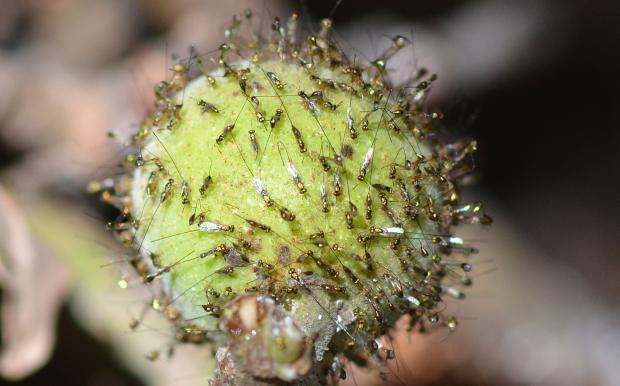
Hundreds of fig wasps congregate on a fig in response to its volatile cocktail
Picture credits: Pratibha Yadav
Do plants talk? Contrary to popular beliefs, plants are as equally adept in the art of signalling and communication as their animal counterparts. Prof. Renee M. Borges from the Centre for Ecological Sciences, Indian Institute of Science, Bangalore, has spent many years delving on the many aspects of plants communication and their language.
Though plants are stationary, a few important phases in their life cycle require mobility – such as during pollination and seed dispersal. At such times, plants seek the assistance of members of the animal world by ‘calling out’ to them. One way they do this is by releasing into air a molecular cocktail (a.k.a. volatile chemicals) that animals can pick up using their olfactory senses. Some examples of such cocktails are the characteristic smells that plants emit during the blooming of a flower or the ripening of a fruit.
Prof. Borges studies the symbiotic relationship between different organisms. In a recently written book chapter in the book Signalling and Communication in Plants: Deciphering Chemical Language of Plant Communication, she explains one of the best examples of ‘plant talk’ illustrating a plant–animal mutual dependence that has been in existence for more than 80 million years – the relationship between the fig tree and the fig wasp.
In this case, the fig – i.e., the fruit of the fig plant, which is actually a hollow flower garden, extends its services to wasps as a nursery for the young ones. Inside the fig are tiny male flowers that contain pollen or female flowers that require pollen for pollination. Mother wasps that hear the ‘smelly’ talk of the fig tree from the figs, fly towards such figs and enter them in order to lay their eggs. When the female hatchlings come out of the nursery, they carry pollen, which can fertilize female flowers inside the next fig they enter.
This mutual dependence is very specific – the wasps cannot breed anywhere else and the plant is exclusively dependent on the wasp for pollination. Most species of fig trees have their own specific species of pollinator fig wasps and the smells emitted from a particular kind of fig can only ‘call out’ to a specific kind of wasp. There are, in fact, around 800 various figs–wasp relationships in existence today.
In the forest, there exist thousands of other such alliances. How can the olfactory system of any animal distinguish a smell signal that is meant for it, from the molecular soup of smells that exist in forests? How did such specificity evolve? How can animals discern a specific signal from the smelly commotion that surrounds it? Do they respond to a single ingredient, or a proportion of ingredients? Can climate changes affect their communication? And more interestingly, how do researchers even attempt to figure all this out? Prof. Borges tries to unravel this puzzle in her work.
“We frequently go to the Bhimashankar Wildlife Sanctuary located in the Western Ghats to study pollination systems in seasonal cloud forests. The sanctuary has a host of endemic plants, animals, and some unique endangered species such as the painted bat”, Prof. Borges says. Their studies include field observations as well as experiments in the lab, and they also work in the forests of Agumbe, Coorg, and the environs of Bangalore.
To observe, experiment and decipher results in a field such as this, researchers need an understanding of diverse subjects such as ecology, chemistry, atmospheric science, fluid dynamics, behaviour and neurobiology. “Ideally, students working in this field need multi-disciplinary training to appreciate the breadth and depth of the area”, says Prof. Borges. “However, this is not so always; students do come in with basic training in either molecular biology, ecology, zoology, botany, life science, or chemistry, and we build the connections using a collaborative effort”, she adds emphasizing the need for a diverse skillset in her research area.
As the professor states in her book chapter, the need of the hour is collaboration between various disciplines that will provide better answers to Jean-Henri Fabre (an early French entomologist), who wrote almost a century ago, “… What is materially emitted by the female Bombyx or Great Peacock? Nothing, according to our sense of smell. Should science one day, instructed by the insect, endow us with a radiograph of smells, this artificial nose will open out to us a world of marvels.”






